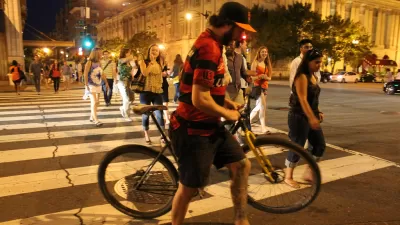While the decline may not be visible, total auto ownership peaked in 2008 according to a new report by Michael Sivak of the University of Michigan's Transportation Research Institute. He set out to determine the cause - was it the economic recession?
As an associate editor at The Atlantic, Jordan Weissmann has been following the reduction of driving in the U.S and written about the reduction in younger drivers. He wanted to know if "the U.S. is getting over car culture", or if the driving reduction was mainly a product of the economic downturn. He looked toward Sivak's findings (PDF) for an insight.
Sivak analyzed the period from 1984 through 2011. He examined the registration "of light-duty vehicles (cars, pickup trucks, SUVs, and vans) for each year from 1984 through 2011."
Its key take-away is that the number of cars per household actually began to decline pre-recession, after 2006. Same goes for cars per licensed driver and cars per person.
In fact, the accompanying graph shows it all, with the vehicle registration rate - per person, per licensed driver, and per household, peaking around 2006 - before the recession which is recognized as beginning in December, 2007 per U.S. Bureau of Labor Statistics (PDF).
Yet, Weissmann is not entirely sold, pointing to pre-recession economic factors, e.g. home values peaked in 2006 and suspects that influenced car ownership rates.
He concludes that "(t)he decline of car ownership might well turn out to be a long-term trend with cultural and demographic roots. But if so, the housing bust and recession still seem to have been the tipping point."
He may be partially correct - if you distinguish between absolute numbers and rate of ownership.
From Sivak's abstract (PDF): "...with the improving economy and the expected increase in the U.S. population, it is highly likely that (from a long-term perspective) the absolute number of vehicles has not yet peaked." However, if you believe Sivak, the rate of ownership peaked seven years ago.
FULL STORY: Has the U.S. Passed Peak Car?

Planetizen Federal Action Tracker
A weekly monitor of how Trump’s orders and actions are impacting planners and planning in America.

Congressman Proposes Bill to Rename DC Metro “Trump Train”
The Make Autorail Great Again Act would withhold federal funding to the system until the Washington Metropolitan Area Transit Authority (WMATA), rebrands as the Washington Metropolitan Authority for Greater Access (WMAGA).

The Simple Legislative Tool Transforming Vacant Downtowns
In California, Michigan and Georgia, an easy win is bringing dollars — and delight — back to city centers.

The States Losing Rural Delivery Rooms at an Alarming Pace
In some states, as few as 9% of rural hospitals still deliver babies. As a result, rising pre-term births, no adequate pre-term care and "harrowing" close calls are a growing reality.

The Small South Asian Republic Going all in on EVs
Thanks to one simple policy change less than five years ago, 65% of new cars in this Himalayan country are now electric.

DC Backpedals on Bike Lane Protection, Swaps Barriers for Paint
Citing aesthetic concerns, the city is removing the concrete barriers and flexposts that once separated Arizona Avenue cyclists from motor vehicles.
Urban Design for Planners 1: Software Tools
This six-course series explores essential urban design concepts using open source software and equips planners with the tools they need to participate fully in the urban design process.
Planning for Universal Design
Learn the tools for implementing Universal Design in planning regulations.
Smith Gee Studio
City of Charlotte
City of Camden Redevelopment Agency
City of Astoria
Transportation Research & Education Center (TREC) at Portland State University
US High Speed Rail Association
City of Camden Redevelopment Agency
Municipality of Princeton (NJ)





























